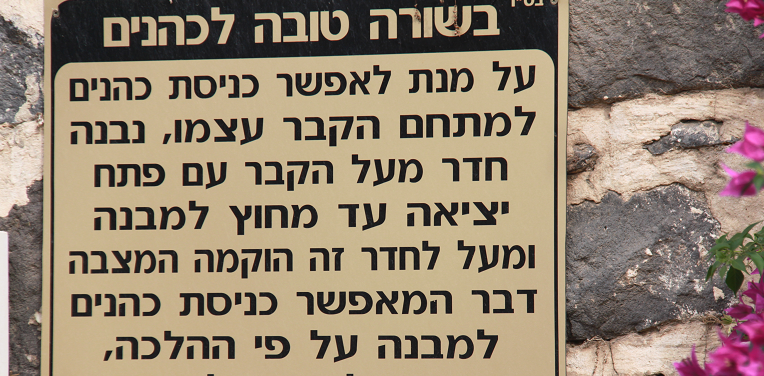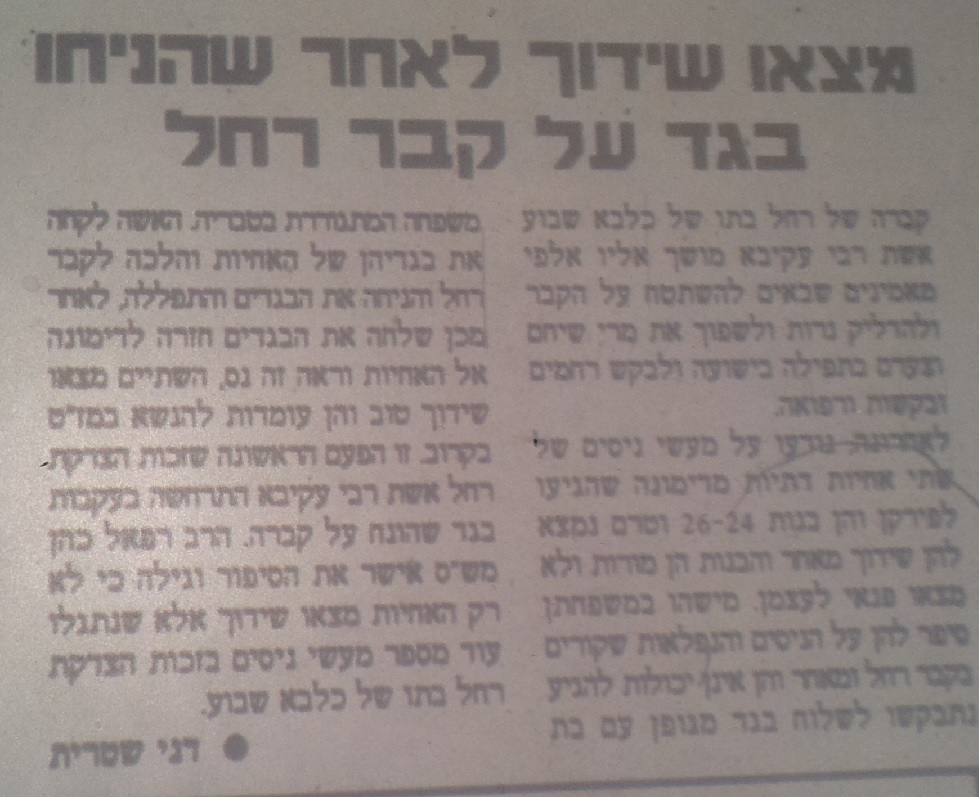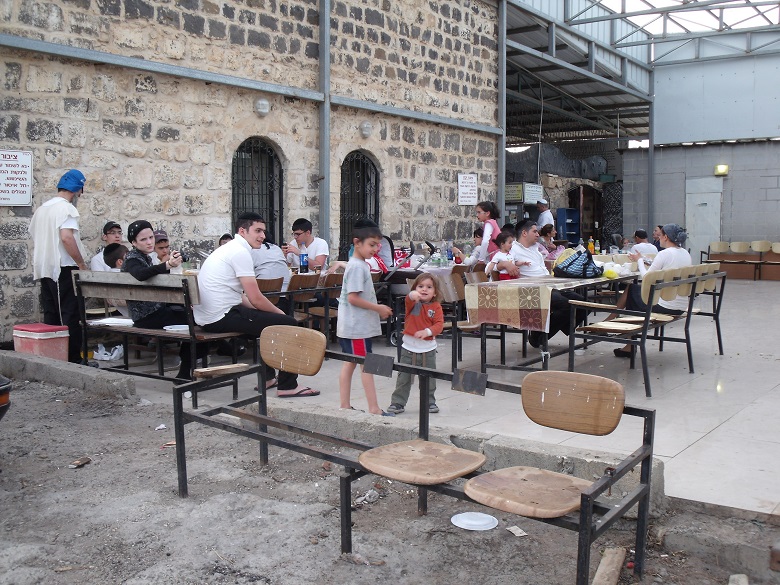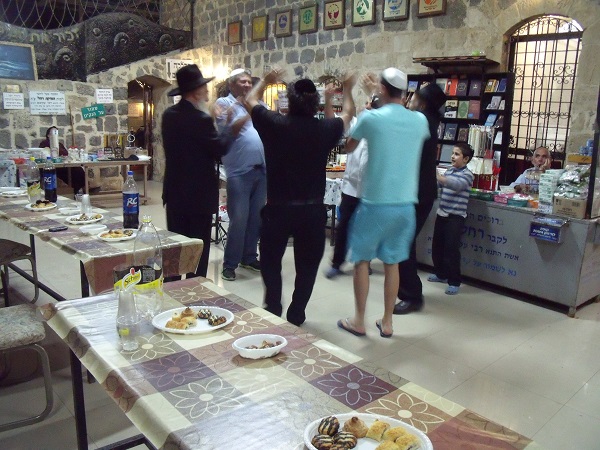






The Tomb of Rachel, Wife of Rabbi Akiva, is located in one of the cemeteries of Tiberias. According to various archeological sources the place was once the shrine of Sit Sukkeina, a Muslim female saint. However, it is currently dedicated to the pious wife of Akiva ben Joseph, the renowned Talmudic sage (ca. 50-ca. 135 CE). Primarily due to the growing intervention of local activists, the venue’s popularity has skyrocketed; and in the process, the immediate environs are being transformed. For example, a well was discovered on the site producing many stories and legends. People come to visit the tomb, pray and kiss the grave.
Nurit Stadler


26/3/2014
While doing archival work at the Israeli National Library, I found the following article which was published in a local newspaper in Tiberias. The article, dated 1996, the year of the tomb's renovation narrates a story of two unmarried women, age 24 and 26 from the south of Israel who sent their clothes to be put on the tomb. Shortly after the garments were delivered back to them, they both found a match. The main impresario, Raphael Cohen, of the newly mythologized site is quoted spoke in the article relating to an additional miracles that have taken place therein 'thanks to 'Rachel.
Lior Chen
21/3/2014
In a regular visit to the site Noa Baron our RA for Rachel's Tomb in Tiberias found this note attached to the Tomb - in this note a woman who did not divulge her name is encouraging other women to pray and ask for help from the righteous, that is Rachel. She narrates how two years ago she came to the tomb and beseeched Rachel to help her find a husband and the following year indeed she got married and now she came again to express her gratitude and thank Rachel as she is anticipating her first borne child. She is encouraging young unmarried Jewish women to have faith and pray for God’s help and to know that they will be rewarded in this place
The Hillula day at Rachel’s Tomb in Tiberias – April 16, 2014
I got to Rachel's Tomb's annual celebration with a fish truck. Gilad (pseudonym) - the driver of the small truck which picked me up – an orthodox Jew approximately 40 years old, started with an apology for the fishy smell inside the truck. But after 20 minutes without any car offering to pick me up, and due to very busy traffic jams on the way to Tiberias, I was anxious already to get to the site, even if it means to feel like I'm in a giant fish barrel. During the ride I spoke with Gilad, a "Baal Teshuva" (literally means one that has repented i.e. became religious and one that leads a religious life), a father of eleven 11 children. Gilad was born in the northerly city Kiryat Shmona and a few years ago he moved to Tiberias. I asked him about Rachel's Tomb. Gilad made a strange expression and told me he was not going over there because there are rumors, claiming that the site is not really Rachel's tomb, but a tomb of a Muslim woman.

The Hillula (the annual day of celebration usually suggests the passing day of the saint) at Rachel's Tomb, which was organized by the Rabbi Raphael, was held on the first day of Passover. The date indicates the "end of the formal struggle over the grave", said Rabbi Raphael. According to him, the first Hillula days were big celebrations with hundreds of participants, but because of the high costs due to the requirement of the presence of a fire truck and an ambulance he decided to discontinue the big celebration. In recent years he holds small celebrations and hardly publish them at all. He will repeat this explanation several times during the evening of the Hillula as if to suggest an apology for the small number of the participants.
The ten kilometer distance between home and site took me an hour as against the regular drive in less sacred days which takes roughly ten minutes. As I entered the tomb’s inner courtyard there were already dozens of people: men, women and children. I have never seen so many people on the site at the same time. The visitors were engaged in various activities. Some were praying in the inner room next to the tomb itself, others just hung around and looked at the products which were sold by the site’s ganitor (but only a few people bought something during the afternoon and the evening hours). The majority were outside, under the back shed, eating the food that they have brought with them to the site or food they had prepared on site, especially grilling meat over portable barbecues they brought along with them . From time to time someone would call for a 'Mincha' (afternoon prayer)and later calls for Arvit were heard (evening preyar).

The internal layout of this site was different from what I saw in past visits. At the very entrance to the complex a portable table was placedThe table carried a placard which informed the visitors that they are invited to to donate money for the purchase of a new Torah book for the site. The man who was sitting behind the desk told me that so far all the Torah books currently in use are old and it is time to introduce a new book which will be written especially for the site. In front of the desk, there was an A4 paper announcement advertising the Hillula. I later learned from Rabbi Raphael (the main protagonist promoting the site from as early as the 1980s) that more copies of the ad were posted in the city. The advertisement narrated that the event will start at half past seven p.m. and will entail refreshments and songs to the guests.
As mentioned above, dozens of people were on the site at the same time. While the majority of the pilgrims lingered on for a few hours and their visit consisted of the ritual meal and prayers at the site there were those who only visited for a short time en route to other places. I walked between the people and asked them where they came from, what they know about the site and if they came especially for the celebration. Most people had come from a far: the furthest point was over two hours ride from the town of Ashkelon. Not one of my interlocutors knew about the Hillula and only a few of them knew more than just rudimentary details about the site. And certainly no one knew or acknowledged the Muslim origins of the place
Three young girls, one of them wearing a short dress, entered the compound and bought a candle to light in the candle room. They looked distinctly different from the people who usually visit the Tomb. I asked them for their reasons for coming and they told me that they saw the place on their way to the beach, and now, on the way back, one of them decided that they must stop here. This was their first visit and naturally they knew nothing about it.

Later, I encountered a sixty years old woman walking along the road which also serves the nearby neighborhoods in addition to the site. I assumed she was a resident of from Achva, the neighborhood adjacent to the Tomb. Surprisingly, it turned out that she is an Bedouin woman from the village of Wadi Hamam. She moved to the neighborhood due to "things which happened in the village" a few years ago. She does not know anything about the Muslim tradition of the tomb. For her, it is solely a Jewish place.
People kept coming and going all through the afternoon and at around seven p.m. the singer arrived and began to organize his equipment. The site's staff: Makhlouf the ganitor, Rabbi Raphael, his young assistant and I with them placed refreshments and beverages on the tables in the tomb entrance hall. A few minutes before seven thirty, the time when the Hillula was set to start, a large group from the town of Carmiel arrived. They gathered at the entrance hall for praying and consequently caused a delay.. When they left the place looked empty and I noticed that only about ten people, including Rabbi Raphael, came especially for the Hillula. The Hillula (that is the actual ritual gathering and ceremony) lasted for an hour and a half and included mainly singing by the invited singer accompanying himself with an electronic keyboard and dances by very few people at a given moment. During this time, people who did not come especially for the festivity and even did not know about it, continued to arrive to the site. A few of them joined spontaneously inthe dance if only for a short time, while the majority continued to the back shed and throughout the event twenty-thrity people sat over there, ate,drank and didn't seem to be at all interested in the event.

The second part of the event was a speech by Rabbi Raphael, very similar to the one I heard him deliver last year. In his speech, he talked about the history of the tomb since the miracle which led to the renovation of the Tomb. Like last year, I felt that he is referring in his words to the researcher "from the university" (last year, we, as in “the people from the university” were more conspicuous as Nurit, Nimrod and Oren Golan were with me during the Hillula). Moreover, earlier, when I asked him if he plans to give a speech he hesitated for a moment before answering me "yes, I think I will". When he hesitated it seemed to me that he thought he might not speak but changed his mind due to my question. Throughout our long conversation during the Hillula he spoke with me about the grave and about the shallow secular world. In response to this "shallowness", he decided to reestablish the large Hillula days starting as of next year. His decision, according to him, is supposed to be an answer to the secular masses that go on the shores of the Sea of Galilee during the intermediate days of Passover.
A few minutes before ten I left the tomb and walked for a few minutes to the to the main road. The festivity was about to the end and the number of people on the site decreased. A few hunreds meters away from the Tomb along the shores of the Sea of Galilee, thousands of people were celebrating the Passover holiday camping and partying rather loudly. No doubt, Rachel's Tomb is gaining popularity as a pilgrimage site, notwithstanding Rabbi Raphael’s struggle against what he described as 'the shallow secular world' is far from over.
Lior Chen
hillula 2014 on the tomb